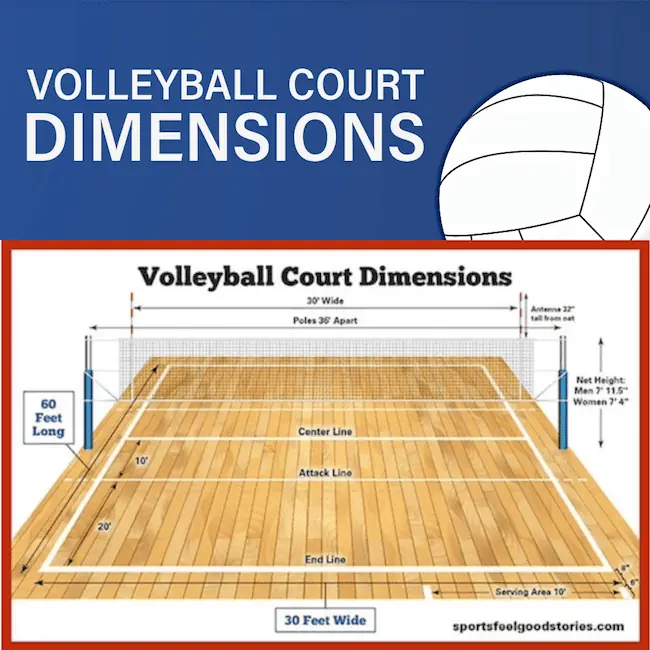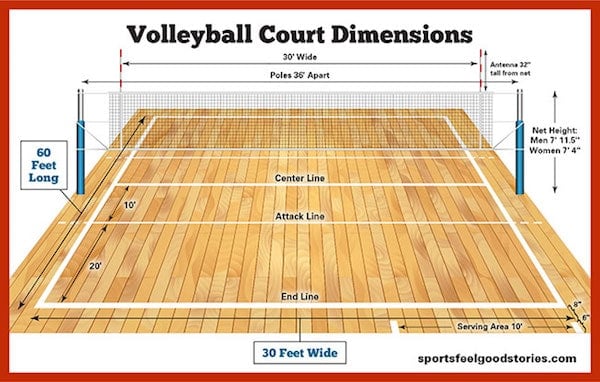Volleyball court dimensions vary depending on league standards, the age of participants, and whether the match is held indoors or outdoors.
If you ever wondered, “What is a volleyball court size?” you’re at the right spot.
The following guide will explain official volleyball measurements and sizes for any league in a Q and A format. Net height, width, pole placement, volleyball weight, and size are addressed. In no time, you’ll be chanting, “Bump, set, spike it – That’s the way we like it!”
Volleyball Court Measurements
Here are the dimensions broken down by league and playing venue.
1.) Indoor Volleyball: NFHS (National Federation of State High School Associations) – High school volleyball court size: 60 feet (18.29 meters) long by 30 feet (9.14 meters) wide.
2.) Indoor volleyball: NCAA, FIVB & USAVB (USA Volleyball) – Official dimensions for indoor volleyball courts: 59 feet (18 meters) long by 29.5 feet (9 meters) wide. The FIVB governing body sets official court dimensions.

3.) Outdoor / Beach Volleyball Court: NCAA, FIVB, USAVB – Court dimensions: 52.6 feet (16m – meters) long by 26.25 feet (8m – meters) wide. The width of the court and length have lines marking the boundaries. USA Volleyball and the NCAA recommend you have a free space of 6m (20′). Note that adjacent courts may share the free playing space.
4.) Outdoor / Beach Volleyball Court: Recreational – Recreational sand dimensions feature a playing area that is 52.5 feet (16 meters) long by 26.25 feet (8 meters) wide. Boundary lines establish the perimeter of the court. The end lines distinguish the length of the court, and the sidelines mark the width. The space above the playing area is typically seven meters from the surface. The playing surface for any court should be flat and even.
Attack Line
Volleyball courts feature an attack line on each side of the net that runs parallel to the net. It is placed three meters from the centerline. These lines separate the frontcourt from the backcourt. The purpose of the attack line is to indicate where back-row players can attack the ball.
Service Zone and Front Zone
The service zone is a 9m wide area behind each end line, extending to the end of free zones.
The front zone is the area between the attack line and the center line. This zone goes from the sidelines to the free zone.
You might like Sports Quotes.
What is the FIVB?
For all forms of volleyball, the international governing body is the Fédération Internationale de Volleyball (International Volleyball Federation), also known as the FIVB.
The FIVB organizes major volleyball events such as the Olympic Games, World Championships, and World Cup tournaments and manages and standardizes competition rules.
What are the Official FIVB volleyball court dimensions?
The FIVB requires that the volleyball court surface be rectangular, 18 meters (or 59 feet) long by 9 meters (or 29.5 feet) wide. Each side of the court measures 9 meters by 9 meters square.
What is the free zone?
The free zone refers to the playable area outside the court’s boundary lines – both sidelines and end lines. For FIVB official competitions, the free zone must be a minimum of 5 meters (16 feet) and a maximum of 6 meters (20 feet) from the side of the court and the end lines.
What is the attack line or 10-foot line?
The attack line is 3 meters for NCAA and FIVB or 10 feet from the National Federation of State High School Associations net. It separates the frontcourt from the backcourt.
What is the service line in volleyball?
A service line is a short line just behind the baseline that a volleyball server stands behind before hitting a serve. Stepping on or crossing over the line during the serve is a violation. For many courts, the baseline serves the same function.
What is the Volleyball Net Size and Height?
Volleyball coaches and players will find these guidelines helpful in establishing the correct net size and height, whether they coach or play in professional leagues (indoor or beach volleyball) or Olympic, NCAA college, high school, middle school, or youth leagues.
Implementing regulation net heights and dimensions is critical to achieving a fair playing field for all participants. Follow these guidelines for all age groups and genders.
Regulation Volleyball Net Size
The official size of a volleyball net is 32 feet long by 39 inches tall. This is consistent with outdoor volleyball.
Volleyball Net Height
1.) How to measure a volleyball net’s height. Net height measurements should be taken from the center of the net. Ensure the net’s sides are not more than 3/4 inches higher than the regulation height. Here are guidelines for all the different net sizes and dimensions.
2.) Men’s volleyball net size and height. Men’s indoor and beach volleyball height of the net is 7 feet, 11-5/8 inches (2.43 meters) tall. The co-ed net size and height are the same.
3.) Women’s volleyball net size and height. Women’s indoor and beach volleyball net height is 7 feet, 4-1/8 inches (2.24 meters) tall.
4.) How tall should the net antenna be? 32″ tall from the top of the net.
5.) Sitting volleyball net size & height. For sitting (disabled) volleyball leagues, the net is lower to the ground. International net height is 3 feet, 9.28 inches (1.15 meters) tall for men’s leagues. For women, the net height is 3 feet, 5.34 inches (1.05 meters) tall.
6.) Youth volleyball net size & height. For youth volleyball, the regulation net height is the same for girls and boys (ages 11-12): 7 feet (2.13 meters) tall. Boys aged ten and under use the same net height as youth volleyball. Girls aged ten and under use a slightly shorter net at 6 feet, 6 inches (1.98 meters) tall.
Please note that net heights vary for men’s, women’s, juniors, rec, and sitting volleyball. Net measurements are required to meet the regulations set by the FIVB, NCAA, NFHS, USA Volleyball, and NFHS.
Volleyball Court Size Diagram

More Volleyball Measurements
Note these other key volleyball measurements.
How tall are the poles holding the volleyball net? The two end poles measure 8 feet 4 inches tall.
How far apart are the net poles for volleyball? The standards should be 36 feet apart.
What distance is the pole from the sideline? Three feet outside of the playing court.
How wide are the lines on a volleyball court? The court’s lines are two inches wide. The centerline is four inches wide.
What should the ceiling height be? At a minimum, the ceiling should be 23 feet high.
What is the size and weight of a volleyball ball? A volleyball ball weighs between 9.2 and 9.9 ounces. The adult-sized ball is 25.5 to 26.5 inches in circumference (65 to 67 centimeters).
Famous Volleyball Courts
Here are some notable volleyball courts in the U.S.
1.) Pauley Pavilion
Home to the UCLA Bruins, Pauley Pavillion is one of the most iconic volleyball stadiums around. It seats over 16,000 people. Edwin W. Pauley Pavillion is located in Los Angeles, California, on the campus of UCLA. In addition to the men’s and women’s volleyball teams competing there, Pauley is also the home arena for women’s gymnastics.
2.) GSU Beach Volleyball Complex
The three courts here have a direct view of the Georgia State Capitol building. The intimate setting has fewer stands, so the focus is almost entirely on playing the game. With the sand court surface, outdoor beach volleyball is the name of the game.
3.) Maturi Pavilion
The women’s volleyball team at the University of Minnesota plays its home games at Maturi Pavilion. Seating about 5,700 fans, the stadium has been in use since 1994. Among the top universities in women’s volleyball over the course of the past dozen years, the Gophers have typically sold out most of their games.
See Slogans for Volleyball Teams.
Volleyball Fun Facts
For you, volleyball trivia lovers, have at it!
1.) Who invented volleyball? William G. Morgan of Holyoke, Massachusetts, in 1895. He originally called it “Mintonette,” after the game of badminton. The game combined various aspects of badminton, basketball, handball, tennis, and baseball.
2.) When did volleyball become part of the Olympics? It was first a demonstration sport in the 1924 Olympics in Paris. In 1964, it became a medal sport at the Tokyo Olympics.
3.) How many times does a player jump in an average match? Over 300 times.
4.) What is the fastest recorded serve? 81.84 miles an hour.
5.) What is the ball made of in volleyball? Typically, the ball is made of leather or synthetic leather exterior. The interior is usually inflated rubber.
6.) Where is the libero replacement zone? It is located within the free zone. It’s usually at the side edge of the team benches.
7.) Where is the substitution zone? It begins at the attack lines and ends at the scorer’s table for each team.
8.) What does rally scoring mean in volleyball? You don’t have to be serving to score a point.
Volleyball Lingo
A.) Pancake: The ball pops up when a player’s palm is flat on the floor.
B.) Goofy: Jumping with the wrong foot first.
C.) Kong: A one-handed block.
D.) Joust: When the ball is directly above the net and opposing players try to push it to the other side.
By Mike O’Halloran
Mike is the founder and editor of Sports Feel Good Stories.
Overtime
You’re on our Volleyball Court Dimensions page.
More Volleyball Pages:
